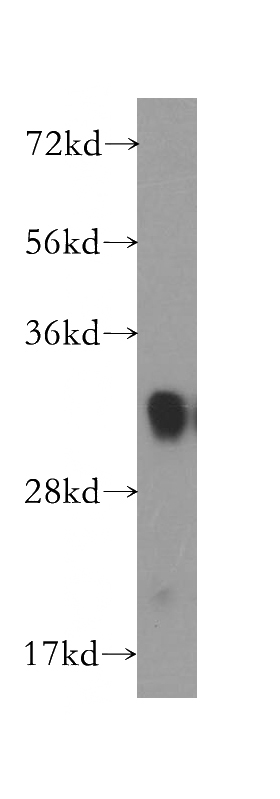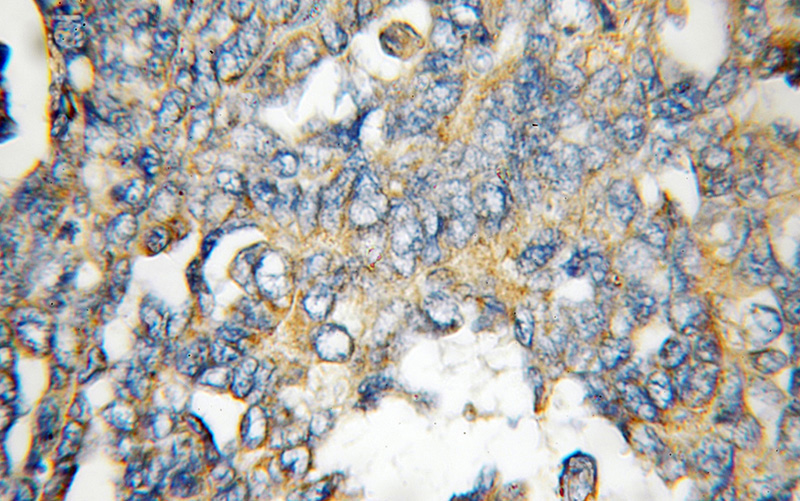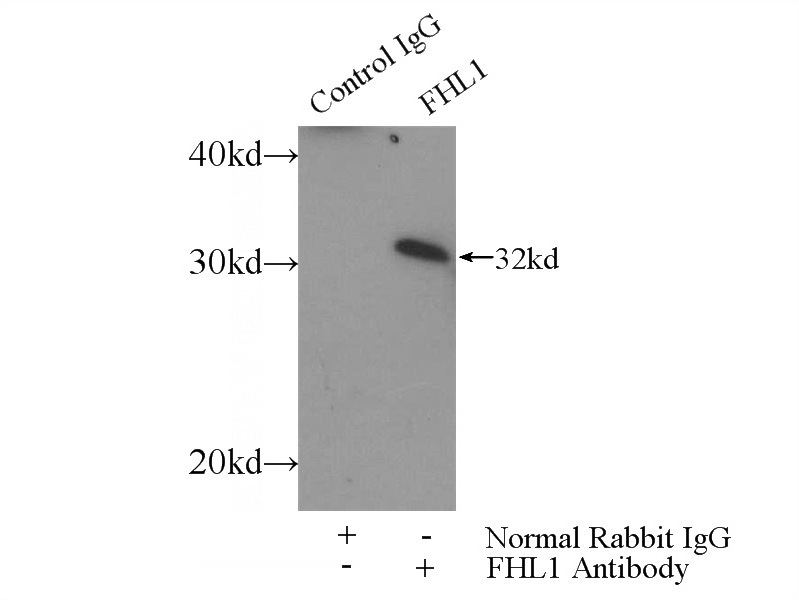-
Product Name
FHL1 antibody
- Documents
-
Description
FHL1 Rabbit Polyclonal antibody. Positive WB detected in human brain tissue, mouse colon tissue, mouse skeletal muscle tissue. Positive IP detected in mouse skeletal muscle tissue. Positive IHC detected in human ovary tumor tissue. Observed molecular weight by Western-blot: 32 kDa
-
Tested applications
ELISA, WB, IHC, IP
-
Species reactivity
Human, Mouse, Zebrafish; other species not tested.
-
Alternative names
bA535K18.1 antibody; FHL 1 antibody; FHL1 antibody; FHL1B antibody; FLH1A antibody; four and a half LIM domains 1 antibody; KYO T antibody; Skeletal muscle LIM protein 1 antibody; SLIM antibody; SLIM 1 antibody; SLIM1 antibody; XMPMA antibody
- Immunogen
-
Isotype
Rabbit IgG
-
Preparation
This antibody was obtained by immunization of FHL1 recombinant protein (Accession Number: NM_001159700). Purification method: Antigen affinity purified.
-
Clonality
Polyclonal
-
Formulation
PBS with 0.1% sodium azide and 50% glycerol pH 7.3.
-
Storage instructions
Store at -20℃. DO NOT ALIQUOT
-
Applications
Recommended Dilution:
WB: 1:500-1:5000
IP: 1:200-1:2000
IHC: 1:20-1:200
-
Validations

human brain tissue were subjected to SDS PAGE followed by western blot with Catalog No:110649(FHL1 antibody) at dilution of 1:1000

Immunohistochemical of paraffin-embedded human ovary tumor using Catalog No:110649(FHL1 antibody) at dilution of 1:100 (under 10x lens)

IP Result of anti-FHL1 (IP:Catalog No:110649, 3ug; Detection:Catalog No:110649 1:700) with mouse skeletal muscle tissue lysate 3600ug.
-
Background
Four-and-a-half LIM domains 1 (FHL1), a member of the FHL protein family, which composed of FHL 1, 2, 3, 4 and ACT (activator of CREM), and characterized by an N-terminal half LIM domain followed by four complete LIM domains. FHL1 may contribute to sarcomere synthesis, assembly and biomechanical stress sensing. FHL1 is also a methylation-silenced tumor-suppressor gene on chromosome X in gastrointestinal cancers, which contributes to the formation of an epigenetic field for cancerization. FHL1(10991-1-AP) is highly expressed in skeletal muscle and to a lesser extent in heart, placenta, ovary, prostate, testis, small intestine, colon and spleen. This is a rabbit polyantibody raised against full length of human FHL1.
-
References
- Ding L, Wang Z, Yan J. Human four-and-a-half LIM family members suppress tumor cell growth through a TGF-beta-like signaling pathway. The Journal of clinical investigation. 119(2):349-61. 2009.
- Loft A, Forss I, Siersbæk MS. Browning of human adipocytes requires KLF11 and reprogramming of PPARγ superenhancers. Genes & development. 29(1):7-22. 2015.
- Lin J, Ding L, Jin R. Four and a half LIM domains 1 (FHL1) and receptor interacting protein of 140kDa (RIP140) interact and cooperate in estrogen signaling. The international journal of biochemistry & cell biology. 41(7):1613-8. 2009.
- Ding L, Niu C, Zheng Y. FHL1 interacts with oestrogen receptors and regulates breast cancer cell growth. Journal of cellular and molecular medicine. 15(1):72-85. 2011.
- Niu C, Liang C, Guo J. Downregulation and growth inhibitory role of FHL1 in lung cancer. International journal of cancer. 130(11):2549-56. 2012.
- Matsumoto M, Kawakami K, Enokida H. CpG hypermethylation of human four-and-a-half LIM domains 1 contributes to migration and invasion activity of human bladder cancer. International journal of molecular medicine. 26(2):241-7. 2010.
- Leitner L, Shaposhnikov D, Mengel A. MAL/MRTF-A controls migration of non-invasive cells by upregulation of cytoskeleton-associated proteins. Journal of cell science. 124(Pt 24):4318-31. 2011.
- Lin J, Qin X, Zhu Z. FHL family members suppress vascular endothelial growth factor expression through blockade of dimerization of HIF1α and HIF1β. IUBMB life. 64(11):921-30. 2012.
Related Products / Services
Please note: All products are "FOR RESEARCH USE ONLY AND ARE NOT INTENDED FOR DIAGNOSTIC OR THERAPEUTIC USE"
